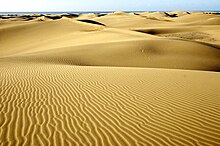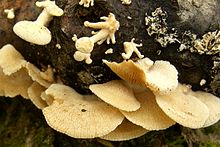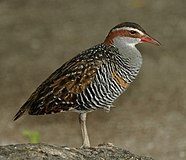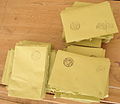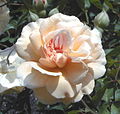Buff (colour)
| Buff | |
|---|---|
| Source | Maerz and Paul |
| ISCC–NBS descriptor | Moderate orange yellow |
| B: Normalized to [0–255] (byte) | |
|
Buff (
As an
Etymology



The first recorded use of the word buff to describe a colour was in The London Gazette of 1686, describing a uniform to be "...a Red Coat with a Buff-colour'd lining".[12] It referred to the colour of undyed buffalo leather, such as soldiers wore as some protection:[13] an eyewitness to the death in the Battle of Edgehill (1642) of Sir Edmund Verney noted "he would neither put on arms [armour] or buff coat the day of the battle".[14][15] Such buff leather was suitable for buffing or serving as a buffer between polished objects. It is not clear which bovine "buffalo" referred to, but it may not have been any of the animals called "buffalo" today.[16]
Derived terms
The word buff meaning "
"In the buff", today meaning naked, originally applied to English soldiers wearing the buff leather tunic that was their uniform until the 17th century. The "naked" signification is due to the perception that (English) skin is buff-coloured.[18]
In nature
Geology
Sand, rock, and loess tend to be buff in many areas.
-
Buff sand
-
Buff rock at the top of a cliff
-
Buff loess
Natural selection
Because buff is effective in camouflage, it is often naturally selected.
-
Buff bands on a snake
-
A moth with buff wingtips (Phalera bucephala)
-
The buff wingtips of this moth aid in camouflage.
-
Bufffungi
Many species are named for their buff markings, including the buff arches moth, the buff-bellied climbing mouse, and at least sixty birds, including the buff-fronted quail-dove, the buff-vented bulbul, and the buff-spotted flufftail.
-
A pair of northern buffed-cheeked gibbons
-
The buff-banded rail
-
The buff-necked ibis
In culture
Architecture
In areas where buff raw materials are available, buff walls and buildings may be found.
-
Traditional buff stone buildings
-
Modern buff brick buildings (centre)
Stationery and art
Unless bleached or dyed, paper products, such as Manila paper, tend to be buff. Buff envelopes are used extensively in commercial mailings.
-
Manila paper
-
Buff envelopes
Buff paper is sometimes favoured by artists seeking a neutral background colour for drawings, especially those featuring the colour white.
-
Red and white chalk portrait on buff paper
-
Black chalk with brown wash, heightened with white on buff paper
-
Graphite drawing with watercolour wash on buff paper
Artificial selection
Buff domesticated animals and plants have been created, including dogs, cats, and poultry. The word buff is used in written standards of several
-
A buff gun dog
-
A buff mousing cat
-
A buff chicken
-
TheBuff Orpington Duck
-
The rose cultivar 'Buff Beauty'.
Clothing
In 16th- and 17th-century
-
17th-century English musician wearing a buff waistcoat
-
17th-century Italian nobleman wearing buff dress boot uppers
John Bull
Clothing depicted on John Bull, a national personification of Britain in general and England in particular,[19] in political cartoons and similar graphic works, has often been buff coloured.[20] Bull's buff waistcoats, topcoats,[21] trousers[22] and boot uppers[23] were typical of 18th- and 19th-century Englishmen.[21]
-
Early depiction of John Bull with the buff clothing typical of an 18th-century Englishman
-
John Bull wearing buff dress boot uppers
-
John Bull wearing buff trousers
17th-century military uniforms
Buff is a traditional European military uniform colour. Buff has good camouflage qualities as sand, soil, and dry vegetation are buff in many areas. The term buff coat refers to a part of 17th-century European military uniforms. Such coats were intended to protect the wearer, and the strongest and finest leathers tend to be buff, so the term "buff coats" came to refer to all such coats, even if the colour varied.[citation needed]
-
Buff German uniforms
-
Dry vegetation in Europe
The British army
The
-
Soldier of The Buffs (Royal East Kent Regiment) wearing "a new Red Coat lin'd with a Buff colour'd lining, .... Breeches of the same colour as the Coat lining."
U.S. Army
The uniform of the American Continental Army was buff and blue.[13]
Buff is the traditional colour of the
The
-
Continental Army uniforms: "The Buff and Blue"
-
US chevron - quartermaster sergeant insignia (1902–1909) buff on black with blue detail.
-
USAIH illustration which specifies "a buff colored vertical rectangular embroidered item"
U.S. universities, fraternities and schools
The colours of
Other school colours described as "buff and blue" include Gallaudet University in Washington, D.C., and Punahou School in Honolulu, Hawaii.
Buff is one of three colours of the Alpha Gamma Delta fraternity, and one of two colours of the Delta Chi fraternity.
-
General Washington wearing the buff and blue
-
George Washington University banners featuring the buff and blue
-
The buff and blue logo of the George Washington University Colonials
U.S. state flags
The flags of
-
1901 Maine Flagflown from 1901 to 1909
Political usage
The colours of the
-
Depiction of the Whig Charles James Fox wearing buff and blue
White Star buff
The
As a relatively inexpensive and readily available paint colour, and one which went well alongside the near-universal black hull and white superstructure used on steamships at the time, White Star was far from the only shipping line to use a shade of buff as a funnel colour. The Orient Line and Norddeutscher Lloyd used an entirely buff funnel without the black top, while Canadian Pacific and the Swedish American Line employed a buff funnel with a representation of the company's house flag on them. The Bibby Line and the Fyffes Line are two of several firms to use the same "buff with a black top" scheme as White Star, but with a similar lack of certainty as to the exact shade used and how this differed from the famous White Star scheme.
-
Ships of the White Star Line, such as the RMS Oceanic pictured here, and the Titanic, had buff funnels with black tops.
In Canadian heraldry
As well as being a colour used by the United States Army Institute of Heraldry, buff is also recognised as a tincture by the Canadian Heraldic Authority. It appears on the heraldic badge and flag of the Correctional Service of Canada.[27]
See also
References
- ^ "Convertor from RYB to RGB". PaintAssistant. Archived from the original on 28 June 2013. Retrieved 29 December 2012. RGB approximations of RYB tertiary colours, using cubic interpolation. The colours displayed here are substantially paler than the true colours a mixture of paints would produce.
- ^ William T. Stearn. Botanical Latin. History, Grammar Syntax, Terminology and Vocabulary. Third edition, revised. David & Charles, Newton Abbot, London 1990
- ^ E. Short, A. George. A Primer of Botanical Latin with Vocabulary. Cambridge University Press, 2013
- ^ The Oxford English Dictionary (OED). Second Edition (20 Volume Set). Clarendon Press, 1989
- OCLC 60411025.
- ^ A. G. Abbott. The color of life. 1947
- ^ G. D. Armstrong. Cyclopedia of painting. 1908
- ^ William J. Miskella, 1928, Practical Color Simplified: A Handbook on Lacquering, Enameling, Coloring And Painting; John Lemos, 1920, "Color Charts for the School Room", in School Arts, vol. 19, pp 580–584
- ^ A. Maerz, M. Rea Paul. A Dictionary of Color. 1950
- ^ A. S. Jennings. Paint and Colour Mixing. A Practical Handbook for Painters. 1906
- ^ R. Ridgway. A nomenclature of colors for naturalists - and compendium of useful knowledge for ornithologists. 1886.
- ^ "buff, adj.1". Oxford English Dictionary. OUP. Retrieved 21 April 2011.[permanent dead link]
- ^ OCLC 936144129.
- ^ Miriam Slater, Family Life in the Seventeenth Century: the Verneys of Claydon House 1984:11.
- ISBN 9781134849352– via Google Books.
- ISBN 0-06-270084-7.
- ^ Robert W. Masters "What is a Fire Buff?", Pictorial History of Firefighting, revised edition, 1967; Steve Hanson, "Fire buffs: who are they?".
- ^ "The meaning and origin of the expression: In the buff". The Phrase Finder. 11 December 2023.
- doi:10.1093/ref:odnb/68195. (Subscription or UK public library membershiprequired.)
- ^ "John Bull Running". Sterling Times. Retrieved 7 August 2012.
- ^ a b "AngloMania: Tradition and Transgression in British Fashion", Metropolitan Museum of Art (2006), exhibition brochure, p. 2.
- Westminster Gazettein the late 1800s and early 1900s.
- ^ "John Bull and His Bulldog". Gold Posters. Archived from the original on 25 January 2013. Retrieved 7 August 2012.
- ^ "Buffs (Royal East Kent Regiment) - Famous Units - Research - National Army Museum, London".
- ^ The TRMA recommend the colour on found on "pp. 54, 60-61, and 67 of the new book Art of Titanic", presumably Ken Marschall's Art of Titanic 978-0786864553.
- ^ Braunschweiger, TRMA, Art. "White Star Buff: Weighing the Evidence". Titanic Research and Modeling Association (TRMA). Archived from the original on 12 October 2011. Retrieved 28 July 2012.
An earlier version of this article appeared on the TRMA website in October 2004 under the title "Photographic and Illustrative Evidence of White Star Buff." In December 2004, the article was rewritten under its present title to reflect new evidence and new debate on the subject since the writing of the original article.
- ^ General, The Office of the Secretary to the Governor (12 November 2020). "Correctional Service of Canada [Civil Institution]". reg.gg.ca.
External links
 The dictionary definition of buff at Wiktionary
The dictionary definition of buff at Wiktionary Media related to Buff (colour) at Wikimedia Commons
Media related to Buff (colour) at Wikimedia Commons

